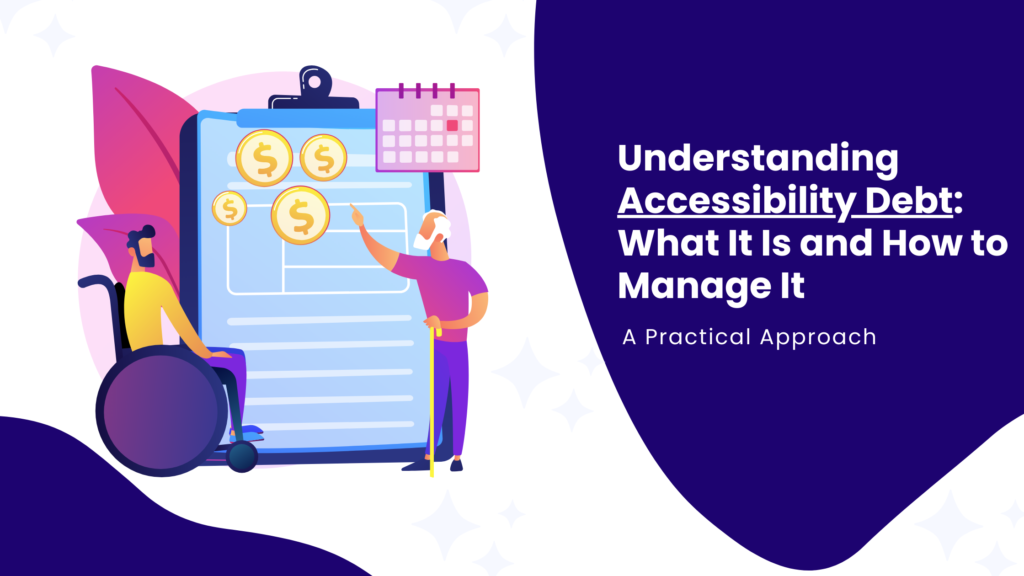Building accessible websites is crucial for ensuring that all users can access online content seamlessly. However, many businesses, due to deadlines or budget constraints, often overlook accessibility during the initial stages of web development.
This oversight accumulates over time and leads to what is known as accessibility debt—the increasing backlog of unresolved accessibility issues that can hinder user experience and compliance with legal standards.
What is Accessibility Debt?
Accessibility debt refers to the accumulation of unresolved accessibility issues that result from design or development choices that don’t comply with accessibility standards such as the Web Content Accessibility Guidelines (WCAG). Much like technical debt, which arises when shortcuts in coding or infrastructure lead to future rework, accessibility debt grows over time as more accessibility concerns are pushed aside.
Every missed opportunity to address issues like improper color contrast, lack of keyboard navigation, or missing alt text on images adds to this debt, eventually creating a bigger challenge to fix these problems in the future.
Key Examples of Accessibility Debt:
- Poor color contrast: Using color combinations that fail to meet the minimum contrast ratios defined by WCAG, leading to difficulties for users with low vision.
- Unlabeled form elements: Forms that lack labels, making it difficult for screen reader users to understand input fields.
- Non-keyboard navigable content: Certain content elements that cannot be navigated using a keyboard, impacts users with mobility impairments.
Why Does Accessibility Debt Occur?
There are several reasons why accessibility debt may accumulate, including:
- Tight Development Deadlines: When teams are under pressure to launch a product or website quickly, accessibility may not be prioritized, with the understanding that these issues can be “fixed later.” Unfortunately, that “later” often never comes.
- Lack of Accessibility Awareness: In some cases, development teams may not be fully aware of accessibility standards or the tools and processes required to meet them, leading to the inadvertent creation of inaccessible features.
- Ongoing Feature Updates: As new features are added to a website or app, accessibility can take a back seat to new functionality. Each update may introduce new issues that go unresolved, adding to the debt.
- Cost Constraints: Addressing accessibility can seem expensive or time-consuming, especially for companies that have not factored accessibility into their initial design and development budgets. This results in accessibility being deferred until it becomes a legal or user experience issue.
The Impact of Accessibility Debt
The more accessibility debt accumulates, the more difficult and costly it becomes to address. Here are some of the key consequences of letting accessibility debt go unchecked:
1. Legal Risks
In many countries, including the United States (under the Americans with Disabilities Act or ADA), Europe (with its Web Accessibility Directive), and India (Rights of Persons with Disability Act 2016) non-compliant websites can lead to lawsuits. Accessibility debt can expose your company to legal risks if issues aren’t resolved in time.
2. Damaged Brand Reputation
Inaccessible websites can lead to negative user experiences for people with disabilities. Word of mouth spreads quickly in accessibility communities, and a reputation for poor accessibility can damage a company’s brand and customer loyalty.
3. Increased Remediation Costs
As accessibility debt accumulates, it becomes more expensive to fix. This is because changes need to be made across multiple areas of the site, often requiring a complete overhaul of existing design and code.
4. Loss of Potential Customers
Websites that are not accessible cut off a significant portion of their potential customer base—about 1 billion people globally who live with disabilities. This can result in lost sales and opportunities as potential customers are unable to interact with your products or services.
How to Manage and Reduce Accessibility Debt
Accessibility debt can be managed and reduced with a proactive approach. Here are some actionable steps you can take:
1. Conduct Regular Accessibility Audits
Performing regular audits of your website or application is crucial for identifying accessibility gaps. Use both automated tools (like Axe or WAVE) and manual testing, including screen reader tests with JAWS or NVDA, to capture a complete picture of your site’s accessibility.
2. Integrate Accessibility Early in the Design Process
Incorporating accessibility into the design phase rather than retrofitting it later helps prevent the accumulation of debt. Ensure designers and developers are trained in WCAG standards and accessible design principles.
3. Prioritize Accessibility in Updates and Features
When rolling out new features, make accessibility a priority from the start. Develop a checklist of accessibility requirements that need to be met for each new release.
4. Create an Accessibility Roadmap
If your company has already accumulated accessibility debt, create an accessibility roadmap that outlines how and when these issues will be addressed. Start by fixing the most critical issues—such as keyboard navigation or text alternatives for images—and work your way through the list over time.
5. Involve Accessibility Experts
Hire or consult with accessibility professionals to guide your team on best practices and legal compliance. This can significantly reduce the chances of overlooking key issues and ensures your website evolves in line with accessibility standards.
6. Monitor and Report Progress
Track your progress by maintaining records of accessibility fixes and improvements. Regularly share these reports with stakeholders to ensure accountability and continued focus on accessibility.
What to do next?
Accessibility debt, if left unaddressed, can lead to major financial, legal, and reputational consequences for businesses. By understanding its causes and taking proactive steps to manage it like hiring an accessibility services provider, companies can improve user experience for all visitors, reduce legal risks, and enhance their brand image. Ensuring your digital assets are accessible from the start, and regularly auditing them for potential issues, will help you avoid the snowball effect of accumulated accessibility debt.

